Four recipes from Gary Mehigan's new cookbook Good Food Every Day
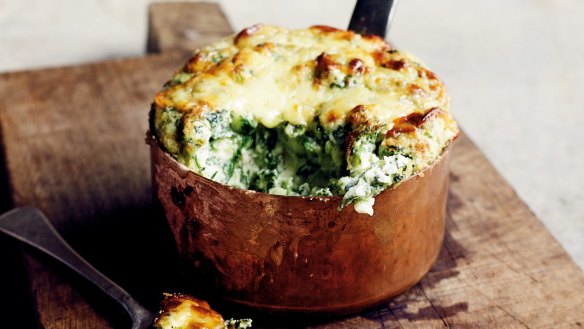
We all like fancy coffee-table cookbooks filled with glamorous and inspirational photos, Gary Mehigan writes in his new recipe collection.
But when it comes to reliable everyday cooking, most of us turn to a handful of books filled with tried and true favourites.
The chef and former MasterChef judge's latest title, Good Food Every Day, aims to be just that – an essential collection of Mehigan's favourite home recipes and go-to dishes you'll have on high rotation in the family kitchen.
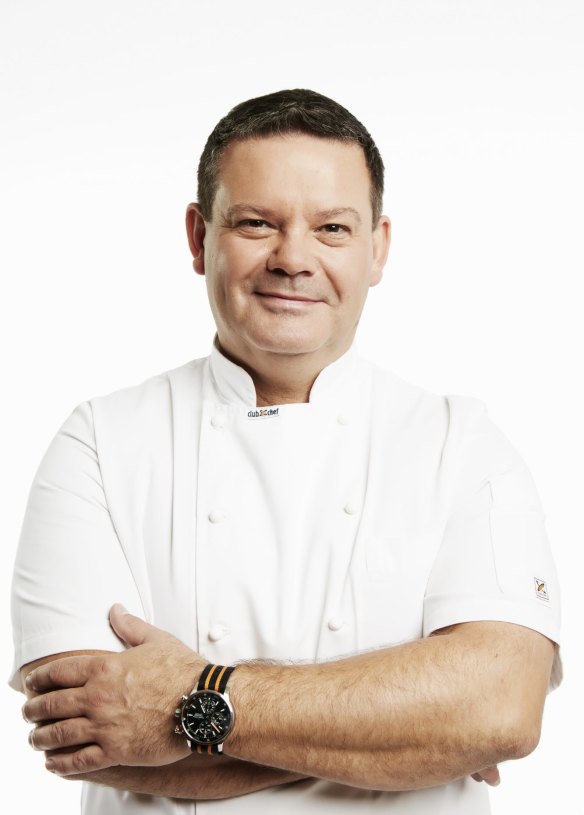
Here are four recipes that give a home-style spin to professional cooking.
Cheddar and spinach souffles
When I wrote this recipe, I wanted a little of Mrs Beeton – an old-fashioned recipe with rustic charm – and I think I nailed it. I could almost have these souffles for breakfast with some ripe tomatoes and a few rashers of bacon, but then that would be greedy, wouldn't it? Any potato suitable for boiling and mashing such as King Edward or sebago work well in this dish.
INGREDIENTS
- 2 potatoes (about 400g)
- 30g butter, melted, to grease
- ⅓ cup (35g) fine dried breadcrumbs
- 100g unsalted butter
- 500g baby spinach, washed and drained 350ml milk
- pinch freshly grated nutmeg
- sea salt flakes
- freshly ground white pepper
- 40g plain flour
- 250g vintage cheddar cheese, grated
- 3 free-range eggs, at room temperature, separated
METHOD
- Preheat the oven to 200C fan-forced (220C conventional).
- Place the potatoes on the middle oven rack and bake for 50 minutes or until tender.
- Remove the potatoes and reduce the oven temperature to 180C fan-forced (200C conventional).
- When the potatoes are cool enough to handle, cut them in half, scoop out the flesh and press it through a fine-meshed sieve with a large spoon (do not overwork or it will become gluey). Cover and set aside.
- Meanwhile, brush the base and sides of six ¾ cup (180ml) souffle ramekins or two 450ml small copper pots with the melted butter. Divide the breadcrumbs among the ramekins or pots and toss to coat the inside. Tip out any excess crumbs.
- Melt 40g of the butter in a non-stick frying pan over high heat, then add the spinach leaves. Cook for a minute or two, tossing once or twice, until the leaves have wilted and softened, then immediately tip into a colander and leave to drain. Once cool, squeeze the remaining liquid from the spinach and set aside.
- Place the milk into a small heavy-based saucepan and bring to the boil, then immediately remove from the heat. Add the nutmeg, and season with salt and pepper. Meanwhile, melt the remaining 60g butter in another small heavy-based saucepan over medium heat, then add the flour. Cook, stirring regularly, for 2-3 minutes or until the mixture looks pale around the edges, then remove from the heat and leave to cool for a minute or two. This is known as a roux.
- Place the pan with the roux over medium heat, then add the hot milk a ladleful at a time to make a bechamel or white sauce, stirring constantly with a wooden spoon until the milk has been combined each time before adding more. Bring to a gentle simmer and cook the sauce for 3 minutes, then remove the pan from the heat.
- Place the potato, cooled spinach and 200g of the cheese in a bowl, then add the bechamel and the egg yolks and stir gently to combine. In a clean bowl, use electric beaters to beat the egg whites with a pinch of salt until soft peaks form. Gently fold one-third of the egg whites into the cheese mixture, then gently fold in the remaining egg whites.
- Spoon the mixture into the ramekins or copper pots, filling them to the top. Sprinkle with the remaining cheddar. Place on a baking tray and bake for 16-18 minutes or until the souffles have risen and are bubbling and golden. Serve immediately.
Serves 6
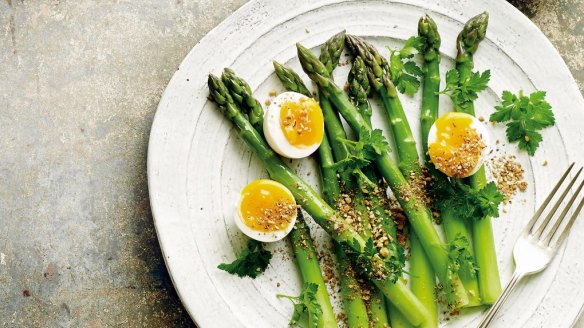
Soft-boiled egg with dukkah and asparagus
Asparagus has such a short season through spring and early summer and it's a vegetable I go mad on when it's at its best. As a chef I love to peel and remove the little spurs on the stalks so they look perfect and pretty on the plate, but even if you just remove the woody base of the stem, there's little else to do to prepare it for eating. I love asparagus thinly sliced with a little lemon and olive oil; grilled on the bars of the barbecue; or thrown into a risotto – it's delicious however you serve it. One last thing: support local producers! The only time you should eat Peruvian or Thai asparagus is when you're on holiday in Peru and Thailand!
INGREDIENTS
- 2 free-range eggs
- extra virgin olive oil
- 8-10 asparagus spears, trimmed
- 1 teaspoon dukkah
- torn flat-leaf parsley leaves, to serve
METHOD
- Cook the eggs in a saucepan of boiling water for 5 minutes, then immediately plunge into cold water. Peel and set aside.
- Meanwhile, heat a dash of olive oil in a frying pan over medium-high heat and cook the asparagus, tossing once or twice, for 3 minutes or until just tender, then season well.
- Cut the eggs in half and serve with the asparagus. Sprinkle the dukkah over and serve with torn parsley.
Tip: Always store eggs in the fridge, then bring them to room temperature before using.
Serves 2
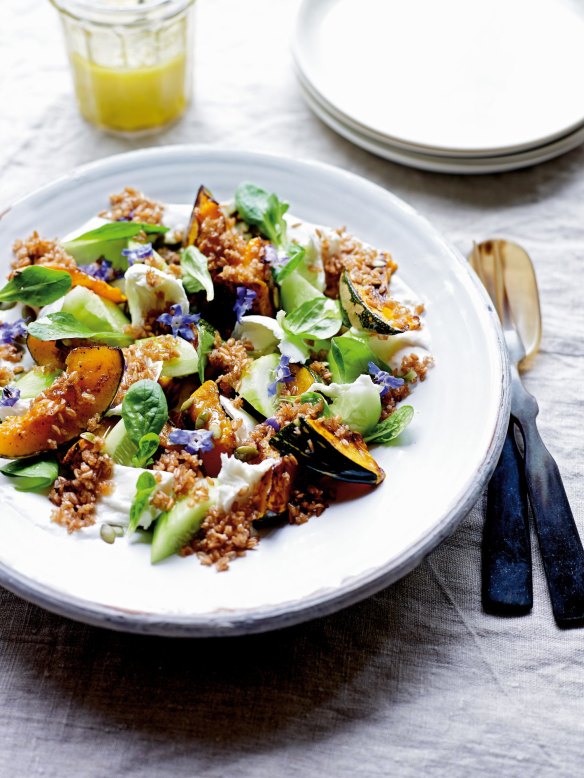
Salad of roasted pumpkin, toasted farro, cucumber and sheep's yoghurt
Before I came to Australia, we ate very little pumpkin in our family (come to think of it, I don't remember Mum cooking it at all). Now, hardly a week goes by when it doesn't feature somewhere in one of our meals. It's up to you whether you peel the skin from the pumpkin or not – I like the taste, texture and the roughage! This salad also contains farro, an ancient wheat grain that's delicious, nutty and satisfyingly chewy.
INGREDIENTS
- ½ (about 1kg) kabocha (Japanese) pumpkin, seeded, cut into 5cm wedges
- ⅓ cup (80ml) extra virgin olive oil
- 2 cloves garlic, smashed
- 3 sprigs thyme
- sea salt flakes
- freshly ground white pepper
- ½ cup (85g) farro
- ½ cup (140g) sheep's yoghurt
- 1 Lebanese (short) cucumber, peeled and cut into bite-sized pieces
- large handful mache (lamb's lettuce) or baby greens
- 1 ball fresh buffalo mozzarella, torn
- 2 tablespoons pepitas (pumpkin seeds)
- 1 teaspoon lavender or bergamot flowers (optional)
Lemon vinaigrette
- finely grated zest and juice of 1 lemon
- 1 teaspoon Dijon mustard
- 1 teaspoon honey
- sea salt flakes
- freshly ground black pepper
- ⅓ cup (80ml) olive oil
- dash extra virgin olive oil
METHOD
- Preheat the oven to 200C fan-forced (220C conventional). Line a large, heavy-based roasting tin with foil and baking paper.
- Place the pumpkin in the prepared tin and drizzle with ¼ cup (60ml) of the olive oil. Add the garlic and thyme and sprinkle with salt and pepper. Toss to combine. Roast for 20-25 minutes or until the pumpkin is tender, turning once, then set aside to cool.
- Meanwhile, bring a heavy-based saucepan of salted water to the boil over high heat, then sprinkle in the farro. Reduce the heat to medium and simmer for 20 minutes or until tender. Drain, then spread on paper towel to remove the excess water.
- Line a baking tray with baking paper and sprinkle over the farro. Drizzle with the remaining olive oil, season with salt and pepper and toss together. Spread evenly over the tray and roast for 15 minutes, stirring occasionally, or until the farro is slightly crisp but still a bit chewy. Set aside to cool.
- Meanwhile, for the vinaigrette, whisk the lemon zest and juice, mustard, honey and a pinch of salt and pepper in a bowl until combined. Gradually add the olive oil, then the extra virgin olive oil, whisking continuously to emulsify.
- Spread the sheep's yoghurt onto the base of a large bowl to cover. Add the pumpkin and drizzle over the roasting juices. Scatter on the cucumber, mache, mozzarella, farro, pepitas and lavender, if using. Finally, drizzle with the vinaigrette and serve.
Serves 4
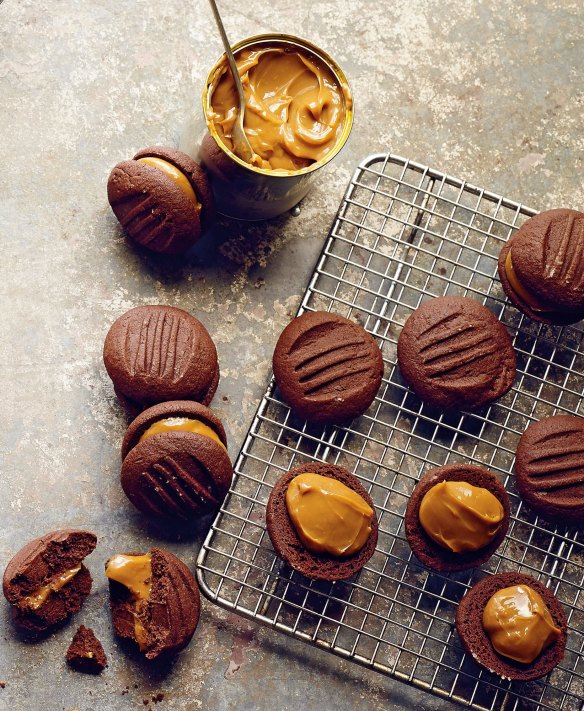
Chocolate and caramel melting moments
You can buy "dulce de leche", a sweet caramel sauce popular in Latin America, in a can or jar from selected supermarkets and delis, or you can make your own. Whereas caramel is made by slowly cooking sugar and a splash of water, dulce de leche is made from slowly cooking cow's milk and sugar together. As the sweetened milk reduces into the coppery brown sauce, a series of chemical reactions (known collectively as the Maillard reaction) occur between the proteins and carbohydrates in the milk. The Maillard reaction is a big part of what makes browned food – from olive oil-fried eggs to grilled bread and roasted vegetables – taste more delicious and intense.
However, if you want a simple way to make your own condensed milk caramel, simply remove the label from the can, place it in a saucepan big enough to immerse the whole can in water and bring to a gentle simmer. Cook for 2-3 hours topping up with water as necessary so the can is always submerged. Cool, open and get stuck in!
INGREDIENTS
- 200g unsalted butter, at room temperature
- 1 cup (150g) plain flour
- ⅓ cup (55g) icing sugar, plus extra for dusting
- ⅓ cup (50g) cornflour
- ⅓ cup (35g) dark cocoa powder
- 1 teaspoon baking powder
- 2 teaspoons vanilla extract
- ½ cup (150g) dulce de leche
METHOD
- Preheat the oven to 160C fan-forced (180C conventional) and line 2 large baking trays with baking paper.
- Use an electric mixer to beat the butter until pale and creamy. Sift the dry ingredients together and gradually beat into the butter, along with the vanilla, until combined.
- Roll heaped tablespoons of the dough into balls and place at 5cm intervals on the prepared trays. Dip a fork lightly in icing sugar and press down gently on each ball.
- Bake for 16-20 minutes or until cooked through. Leave on the trays for 5 minutes before transferring to wire racks to cool completely.
- Smear half the biscuits with dulce de leche, then sandwich together with the remaining biscuits.
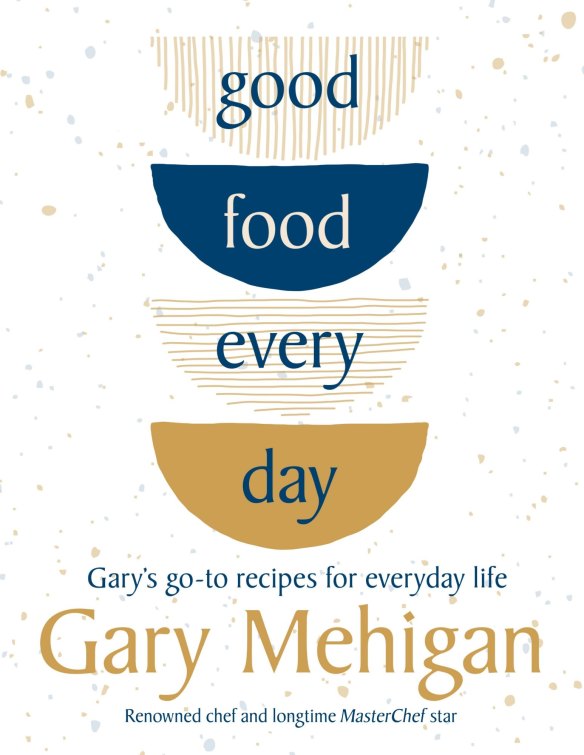
Makes about 10
This is an edited extract from Good Food Every Day by Gary Mehigan (Lantern). Photography by John Laurie. RRP $39.99. Buy now